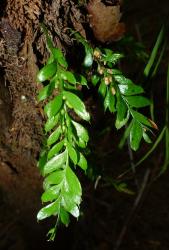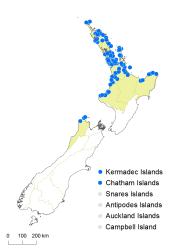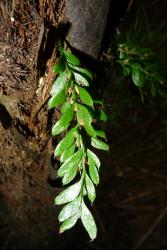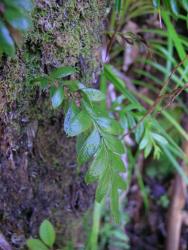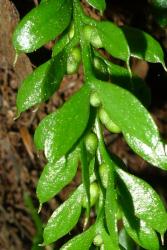- ≡ Tmesipteris tannensis var. lanceolata (P.A.Dang.) Domin, Biblioth. Bot. 20 (85): 232, tab. 1, fig. 4 (1915)
Epiphytic ferns. Aerial stems pendent or horizontal, 30–185 mm long, 8–40 mm wide, unbranched, of determinate growth terminated by a large sterile leaf. Leaves ovate or elliptic, straight or slightly falcate, distichously arranged, shiny green on upper surface, dull green on lower surface, coriaceous; the longest 7–23 mm long, 2–8.5 mm wide, borne from just above to just below mid-stem; apices cuspidate or rarely truncate, with a mucro 1–2 mm long. Sporophylls usually in the proximal half of the stem. Synangia 2–5 mm long, 1–2.5 mm high; lobes equal or slightly unequal, conic to round-ended; the lower surface of each lobe appressed to the subtending leaf margin along its length; the conic apices projecting laterally or slightly downwards.
This species is easily recognised by its shorter stems, distichously arranged leaves, and synangia which are usually confined to the lower part of the stem. The leaves are also shiny green, and ovate or elliptic in shape, unlike the other species which generally have duller leaves that are longer and narrower in outline.
Some plants from Northland and Great Barrier Island differ from T. lanceolata in having the synangia confined to the upper half of the stem. They resemble T. norfolkensis from Norfolk Island but further work is required to determine their true identity.
North Island: Northland, Auckland, Volcanic Plateau, Gisborne, Taranaki.
South Island: Western Nelson.
Kermadec Islands, Chatham Islands
Altitudinal range: 0–500 m.
Tmesipteris lanceolata occurs through Northland, Auckland, and coastal Bay of Plenty as far as East Cape, and along the west coast south to New Plymouth. It is found most commonly in coastal and lowland forest but reaches 300 m in the Hūnua Range, 450 m on Raoul Island and over 500 m in the Hokianga district and on Mt Moehau, Coromandel. It is known from just three South Island collections in North-west Nelson, between Kaihoka Lakes and Kahurangi Point where it grows to 60 m, and from one collection on the Chatham Islands (AK 296646).
Also New Caledonia.
Tmesipteris lanceolata is found as an epiphyte on tree fern trunks, most commonly on Cyathea dealbata, C. medullaris and Dicksonia squarrosa, but it has also been reported on D. lanata (Chinnock 1975). On Raoul Island it grows on Cyathea milnei. It occurs in kauri, podocarp, pōhutukawa and broadleaved forest, and tall kānuka scrub.
n = 104 (Brownsey & Lovis 1987).
The holotype of Dangeard’s Tmesipteris lanceolata has probably been destroyed (Chinnock 1975), and Dangeard’s illustration was therefore selected as lectotype (Chinnock 1998). The type locality, "Montagnes-Bleues", was most likely to have been in New Caledonia where the species is common (Chinnock 1998).



